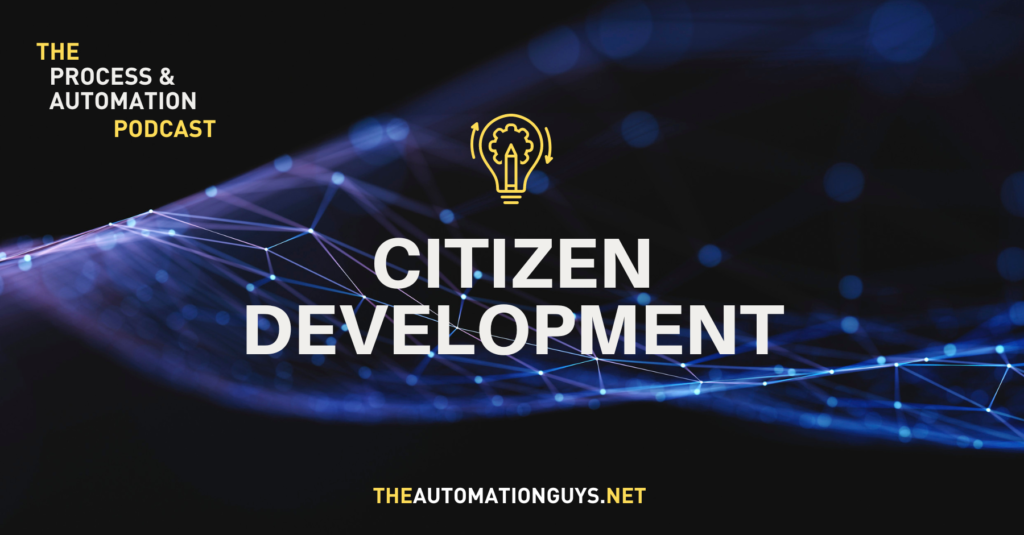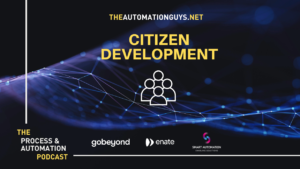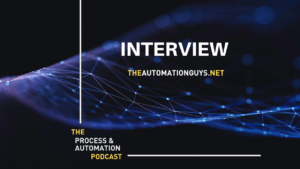Blog

#63 Part 2 of our Citizen Development Series: Five Steps to Become a Citizen Developer
Do you have a citizen developer program for your business users? Has your organization implemented automation to enhance its processes? The Automation Guys are explaining what to focus on when choosing an automation platform, what tools you would need and what are the five steps to get you on the path to becoming a citizen developer. Listen now!
Share This Post
The #1 source of knowledge for everything automation: https://theautomationguys.net
Do you have any questions? Would you like to give us feedback? Are you interested in workshops on the topic of automation? Are you an expert in the field of automation and would like to be on the podcast? Let us know: https://bit.ly/3lyq9Yj
Episode Transcript
Sascha: Hello and welcome to another episode of the Process and Automation podcast with The Automation Guys. As always with me here is Arno, and today we will talk about Citizen developer and more specifically, um, we will share a couple of steps for you to become a citizen developer. If you, you were like many business people, you spend probably more than 40% of your day on manual and administrative tasks, and yeah, imagine if those tasks could be automated.
Accelerating your work, increasing your productivity, and freeing you for tasks that actually require your expertise with robotic process automation or in short RPA, the software robots, the software bots can be created to automate your manual work, your tedious tasks, and work nonstop with a hundred percent accuracy.
That would require IT to handle the automation, and that’s extremely busy with all the other projects. Um, uh, yeah, this is what, what you probably say, like, like many other people out there but Arno, you have some thoughts around that?
Arno: Yes. Um, okay. There is a, a way, uh, to transform your work without depending on IT for development and you might be asking yourself, you know, how, and by becoming a citizen developer, that’s the sort of answer to this. Um, and, you know, put this in other words, um, you know, with minimum training and, and tools designed for people, we don’t live and breathe technology. You can actually learn to automate your day-to-day processes.
You know, doing so without, depending on these IT specialists. So, you know, what would it take to add the title citizen developer to your name and breed, the benefits of creating your own software bots, for example. And, you know, we want to sort of roll this up in five easy steps to achieve that. Now, step number one is to connect with your automation leader in your business.
And again, if your organization has implemented automation to enhance its processes, you know, you, you are on your, you are already on your way there. Um, you know, some organizations, uh, with, uh, pre-existing automations, um, have already created a, a citizen developer program for their business users. And, you know, I would say reach out to your, uh, centre of excellence or your IT leader to learn if there is a, a program in place.
And you know how you can get involved. Um, if such a program doesn’t exist yet, perhaps you can suggest it. Another prerequisite, uh, to becoming a citizen developer is having a automation platform and tools that allows for cell service. Um, you know, and again, not all platforms are created equally. Some require extensive programming expertise with complicated tools for developing software bots.
Um, but hopefully, you know, the platform that, you choose what you want to kind of choose to focus on I guess end user friendliness, uh, that’s easy to, uh, operate with, easy, accessible tools for example, the low-code or no-code or cloud-based options. These will help you to, to simplify development and, and kind of get you on the path to, uh, becoming a citizen developer.
Sascha: Yeah, that’s cool. The step number two is really get up to speed. Um, yeah. In your organization, you will also need, need a way to provide that training. So some organization might leverage, vendor offered citizen developer classes or academies, for the users and those courses cover usually, uh, the basics of RPA and how to use tools created specifically for citizen development. So, like Arno mentioned earlier, sort of code tools with low code and no code and, um, yeah, and some, some other organizations work with these software vendors to offer custom or in-person training.
So you’re going in a typical classroom potentially, or you get a tailor made, um, core specifically for maybe a certain tool set, et cetera, or deep dives in all sorts of automation and all sorts of stuff. But online classes are, um, also available. So through these universities, academies of these vendors, um, and industry education companies that, um, that also look over citizen development concepts.
And they are general information videos, tutorials, also on, on YouTube or other streaming services for, for most of the, the deleting RPA platforms.
Arno: So step number three is build your first part. So you’ve got the basics covered now, um, you’ve got the tools now you’re going to automate. And, um, a software bot should have a purpose.
And you know, the question is, what specific process do you want your first bot to handle? And you’ve probably been thinking about that process before, you know, you knew about this whole citizen development concept. And you know, again, even so, you know, is it the right candidate for you to use, uh, as your first bot, for example?
So that’s a question you need to ask yourself. Is it a simple bot? Is it complicated? And, and the general rule here is to start small and simple. You know, for your first bot, uh, an easy process that’s stable and doesn’t have many variations. That’s usually the kind of the go-to rule.
And, you know I would say that you should follow kind of three, three steps, a three step path. The first one is to start with the requirements of the process and what you want to build, understand those, lay those out, break those down, um, into logical steps. Um, and, you know, create a flow chart that help you visualize the flow so that that’s, that’s kind of like the first and the second step.
And then the third step is to build a bot that actually mimics that flow chart and ensure it meets the needs of your initial requirements. And you can always kind of check, check back and say, well, this is what I wanted this bot to do here is how I mapped it out and when I actually run the bot, it does do that.
You know, learning to become a good citizen developer is no different than learning any other skill. And then, you know, it takes observation, repetition and lots of practice. And, you know, on the automation guys, we’ve got a specific subscription that we allow our members to, to have access to.
And effectively it’s a automation sandbox that’s got robotic software installed. It’s a safe place that these tools are there to, um, for you to build your first bot. So again, I would encourage all the listeners out there to have a look at our, uh, membership, and specifically the offer that allows you this, the sandbox and that that’s a perfect way to, to start playing around with robotics.
And, you know, hopefully you can then build your first.
Sascha: We also enhancing that, uh, sandbox, so to really keep it up to date was, um, lots of, um, uh, relevant, um, uh, modules. So, um, you, you can actually grow with that sandbox, so it’s current for what happens in, in corporations and companies these days.
Yeah. And, um, yeah, our next step, uh, to become a citizen developer is look for the bigger automation opportunities. So Arno mentioned about sort of getting started with that with the first part, and, but after you, you mastered creating a bot for one simple task, get stronger, flex your knowledge and consider what can be done to automate processes end-to-end throughout the organization.
And of course, share your automation success with your co-workers. This is such an important thing. And, and also to help them to give them a lift in their day-to-day efforts as well. So usually when that excitement is there, um, in your own department, you can get this excitement on and lots of other people, uh, will go with that, um, success as well. So they will, will get really excited, uh, yeah, really assist them in identifying, new pain points where automation can, make a difference and bring really big impact. As mentioned earlier, uh, with your first spot, you probably already had a process in mind to automate, so now you are ready to hunt for really, really other good candidates and you shouldn’t do it alone. Yeah. So you have obviously, other colleagues in your organization get help with identifying these candidates by using specialized tools as well and, get the knowledge from other departments. But with these tools, um, the organization can find out lots of, uh, um, sort of information on, uh, high volume processes where things going wrong. So these tools are offered, um, maybe already in your organization or they are coming, with these RPA vendors, specifically task mining, process mining tools, and if your organization uses other bots, check them out to help you get ideas for more automation possibilities. And yeah, you can also explore the community, um, uh, in, um, the automation guys community and share, um, share maybe ideas on what can be automated and lots of RPA vendors have, um, have marketplaces with lots of discussion as well. Yeah. So, so there you find lots of more inspiration.
Arno: Yeah. That’s great. Thank you. And. Step number five is really to make it official. So at that point, um, I guess you would’ve earned your, um, you know, uh, citizen developer credential. You’ve built your first bot. Um, you know, you’ve started to fish for bigger opportunities out there with inside your organization.
You know, and like I say, after you built your first few bots, you discovered you like being a citizen developer, so why stop there? You know, there, there are many opportunities out there, um, to expand your skillset. Um, we always say, you know, take advantage of any classes that’s presented through your organization, if, if any of those are available, or go to your RPA vendor and, and look at any classes that they provide on the specific platform that you use, um, to build your bots in. Be in lookout for bot building tutorials that can help you on your journey as a citizen developer. And again, many organizations have a sort of a training offer to certification and that will help you to, to reach advanced proficiency in RPA development and take charge of your automation success, get started as a citizen developer and automate those mundane tasks. Like Sascha said earlier in the program, over sort of 40% of your day-to-day tasks are manual, repetitive administrative tasks, so if you can really start to automate those, I think it is a more exciting world to live in. Um, you know, when you have these bots at your disposal to automate some of those tasks. And again, then you can focus on, on things in your organization that that adds value. And you can always showcase your, show off your skills to your colleagues.
So, yeah. You know, just continue on the, the, the track, build more bots, use more bots and, you know, again, what, what better way to, to, to, um, use these five steps in, in this program to, to get started. And, uh, like I said earlier, we, we have got an automation guys sandbox area, it has got all the tools that you need to get started.
It’s a safe environment so you don’t risk breaking anything. Um, and you know, it’s a perfect place where you can experiment and, and really build up those skills to be a, a proficient citizen developer.
Sascha: Yeah. And citizen developer, citizen Development actually doesn’t, doesn’t really, um, stop at RPA.
So we, we talk a lot about RPA and, um, being a citizen developer, specifically with rpa. But yeah, we, we touched lightly on it before. So it could be a no-code, low-code application. That’s mainly, mainly the, um, what it is these days. It could be on rpa, it could be on workflow, it could be app development.
So lots of areas. So, so when you go down that route to become a citizen developer, um, it has so many flavours. Um, but what all these things have in common is you don’t need to be, uh, um, a high level developer. You can get started, you can be even a high level developer as well, and then use all these tools but, um, but generally, yeah, you don’t need these skills so deep technical skills, you can just get going with it in pretty much all areas of automation, um, process management. So yeah, it’s, it’s a, it’s a great area to get started with. And yeah, our send box, as Arno mentioned, yeah, get you there so check that out on theautomationguys.net.
Get started, automate as much as you can, we are here very soon again with another episode, and until then, let’s automate it.
Unfortunately, that’s it again with this episode of the Process and Automation Podcast. If you like this episode, please give us a five-star rating and don’t forget to subscribe to this podcast so you don’t miss any upcoming episode. We hope you will tune in next. And until then, let’s automate it.
- November 2, 2022
- 7:52 pm


